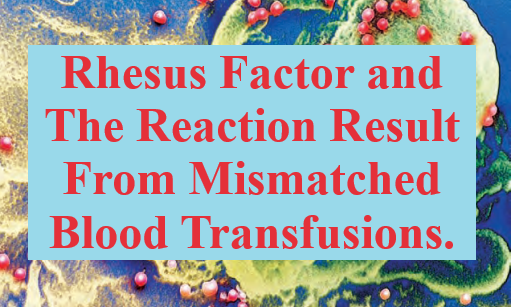The Reaction Result From Mismatched Blood Transfusions.

The Reaction Result From Mismatched Blood Transfusions.
A person’s blood type is determined by certain antigens found on the red blood cell surface.
These antigens are clinically important because they must be matched between donor and recipient during a blood transfusion.
ABO groups
The protein–sugar complex on the surface of the red blood cells acts as an antigen, and these antigens differ with regard to the sugar present (or absent, in the case of type O).
The immune system is tolerant to its own red blood cell antigens but makes antibodies that bind to those that differ, causing agglutination (clumping) and lysis of foreign red blood cells.
Apparently, IgM antibodies made in response to carbohydrates on bacteria that are part of our normal flora also recognize the monosaccharide differences on red blood cells.
Such antibodies are not made against carbohydrate patterns that are also present on our own cells.
Rhesus factor
Another important blood-borne antigen is the Rh antigen or Rh factor.
This protein is either present (Rh positive) or absent (Rh negative) on the surface of red blood cells.
An Rh-negative person who receives an Rh-positive blood transfusion produces antibodies to the foreign Rh protein on the transfused cells.
An additional complication occurs when Rh-negative mothers carry Rh-positive fetuses, which may result in the infant exhibiting a condition called hemolytic disease of new borne (HDN).
A first child is usually not harmed; however, at the time of the first birth, the Rh-negative mother’s immune system may be exposed to fetal blood.
As a result, the woman may become sensitized and produce antibodies and memory B cells against the Rh antigen.
If any exposure to fetal blood occurs during a subsequent pregnancy, IgG antibodies, secreted on activation of these memory cells, can cross the placenta and cause destruction of the red blood cells of the fetus.
Blood typing is done by taking advantage of the circulating IgM antibodies, which are produced against foreign blood antigens but not against self.
If type A blood is mixed with serum from a person with type B or type O blood, the anti-A antibodies in the serum cause the type A red blood cells to agglutinate.
This does not happen if type A blood is mixed with serum from another type A individual or from a type AB individual.
Similarly;
If serum from an Rh-negative individual is added to red blood cells, agglutination of the red blood cells indicates that they came from an Rh-positive individual.
This individual’s blood would not be an appropriate match for transfusion.
Typing of blood prior to transfusions prevents destruction of mismatched cells by a transfusion recipient, as described next.
Over 20 blood groups, including the ABO and Rh groups, have been identified.
Most variants of these other blood groups are rare, but individuals at risk for mismatch may need to “stockpile” their own blood before effective surgery, a practice termed autologous blood donation.
Transfusion reactions result from mismatched blood transfusions
Prior to the advent of blood typing in the early 20th century, transfusion of blood was a last resort because of the danger of death from transfusion reaction.
An immediate transfusion reaction occurs when an individual receives blood that is not correctly ABO matched.
Typically, within 5 to 8 hours of the start of the transfusion, tremendous intravascular hemolysis (rupture) of the transfused red blood cells is detected.
This rupture is a result of IgM binding to foreign antigens and activating the complement system.
The result is the formation of MACs in the red blood cell membranes and rapid osmotic lysis of the cells.
The hemoglobin released from the red blood cells is con- verted to a molecule called bilirubin, which is particularly toxic to cells and can cause severe organ damage, especially to the kidneys.
The major treatment in such situations is to stop the transfusion immediately and to administer large amounts of intravenous fluids to “wash” the bilirubin from the body.
Join Enlighten Knowledge WhatsApp platform.
Join Enlighten Knowledge Telegram platform.
Follow our:
FACEBOOK PAGE.





